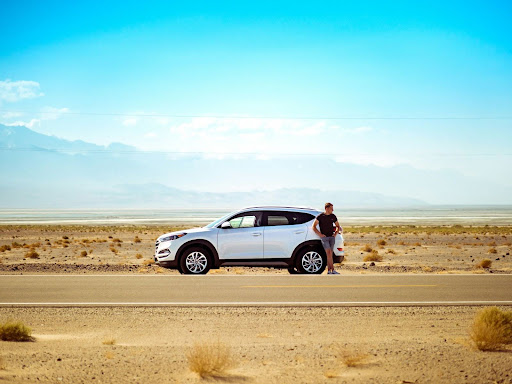Picking the right performance tires can improve tire performance and lifespan in the hot summer months. The benefits of winter weather tires are well known, but the importance of summer tires is just as important for the performance and longevity of your high-temperature tires. Read on to understand more about how summer heat will affect your passenger tires and how to stay ahead of any changes for a peaceful ride.
How summer heat can make driving a challenge
Summer heat and weather conditions don’t only affect passenger tires. It affects the whole driving experience. Here are some summer heat results that can be dangerous and how to avoid any accidents caused by them.
Fog
This is especially common in summer mornings. Fog reduces all-around visibility while driving. Drivers are less likely to see cars in front or behind them, as well as any pedestrians, bikers, or animals that might be on the road. Fog can even be thick enough to hide stop signs and lights ahead so drivers won’t know if they’re approaching an intersection at which they should be stopping.
In foggy conditions, drive with caution and at lower speeds. If you can see other vehicles, give yourself extra time to stop. Use the vehicle’s fog lights. Don’t pass other vehicles on the road since you can’t see what’s coming, and if you have to stop, don’t stop on the road, pull off to the side where you’re out of harm’s way and put on your hazard lights.
Sun glare
Of course, the sun is normally out during the summer, but there isn’t always a glare that affects visibility. Sun glare is usually at sunrise or sunset. It’s even worse on winding roads with lots of hills as the glare makes the road impossible to see.
With this circumstance, follow the speed limit and lower the speed when the glare is seriously affecting your ability to see ahead. Leave yourself extra stopping distance. In general, keep your windshield clean and intact so when this situation arises, there aren’t any extra hindrances to vision.
Heavy rain
A storm can start at any moment in the summer and can also include heavy rain that affects vision and makes the roads slick. In torrential thunderstorms, it can feel like windshield wipers can’t move fast enough to keep rain from blurring the road. In that case, slow down, or pull over if it’s not safe to drive.
The roads will also be wet which increases the risk of hydroplaning. Again, a lower speed and extra caution on the road will help. Avoid puddles, potholes, and the side of the road where water accumulates.
The impact of high heat on tires
Just as our skin is subject to the effects of extreme heat and sun, so too are light truck tires and passenger tires. Performance tires are manufactured differently based on the weather they’re supposed to be serving. But as a driver, there are also things you can do to protect your vehicle and its tires.
When the heat rises, the air molecules within the tire expand. This results in a rise in the tire pressure. Higher tire pressure expands the tire, essentially blowing it up, and stretching out the rubber so it’s rounder. Rounder tires mean less surface area is touching the road, i.e. less handling and traction which is detrimental in rainy weather.
An over-inflated tire is also more likely to burst if punctured or struck. It reduces handling, stability, and traction capabilities. It also starts to wear on the performance tires unevenly.
As mentioned, summer tires and winter tires are made differently to maintain optimal performance in respective weather. Winter tires should not be used in the summer for many reasons, one of which is the compounds used aren’t meant for heat. Winter tires are made to stay soft and pliable even when the temperature drops, so in higher heat, their integrity is lost and tread wear increases rapidly.
The risks of the wrong light truck tires during summer
Using the incorrect tires that aren’t made for summer heat and conditions will result in extra fuel consumption, reduced handling, and lower safety.
The rolling resistance of winter tires on summer roads increases, lowering fuel efficiency. The tread design and sidewall structure of winter tires aren’t made for summer driving so they’ll be more difficult to drive with and affect handling. With a decrease in handling capability comes a decrease in safety as the driver can’t make quick, smart decisions with the incorrect tire.
The benefits of Sailun summer tires
Heat-resistant tires improve safety, durability, and performance. The Atrezzo TCON is one of the high-temperature tires that excels on all fronts. It’s one of our all-season, light truck tires designed with all of today’s contemporary trends and customer needs in mind, no matter where they call home.
It’s built with advanced polymer (solution polymerized styrene butadiene rubber) for gripping to deliver outstanding traction on wet and dry roads and shorten the braking distance. This is our TCON technology (Total Control).
The tires have a large contact area with the road for increased traction and lower treadwear as the pressure is evenly distributed. They’re excellent for controlled handling with a high-tension cap ply and high-rigidity bead.
The right tires should always be used, even if that means having one set for the winter and one set for the summer. A quality pair of all-season tires will do the trick if you live in a mild climate that stays relatively consistent year-round.
Otherwise, get a high-quality set of heat-resistant tires with the fluctuating humidity, heat, and storms that are on the horizon with summer. Browse our tire lineup for a tire that fits your vehicle’s rims and a set that will accommodate your driving habits.


